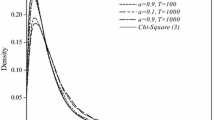Abstract
The paper considers nonlinear logistic smooth transition autoregressive (LSTAR) process and aims to detect the unit root under the null hypothesis of a random walk process against the alternative of a stationary LSTAR process and to estimate the parameters of the process in Bayesian framework using MCMC. The simulation study is carried out for investigating the performance of the Bayes estimators for parameters and Bayesian unit root test and it has been observed that the estimates of parameters of the LSTAR process are close to the true parameter values. It has been observed that the Bayesian unit root test performs well and the power of the test is high even for the boundary cases having root close to unity, at least when the sample size is large. Since the LSTAR models are widely applied for real exchange rate modeling, the theoretical results are illustrated empirically for the real exchange rates of ten OCED countries.

Similar content being viewed by others
References
Arango, L.E., and A. Gonzalez. 2001. Some evidence of smooth transition nonlinearity in Colombian inflation. Applied Economics 33: 155–162.
Buncic, D. (2017). Identification and Estimation Issues in Exponential Smooth Transition Autoregressive Models, 30th Australasian Finance and Banking Conference 2017, SSRN Electronic Journal.
Chan, K.S., and H. Tong. 1986. On estimating thresholds in autoregressive models. Journal of Time Series Analysis 7: 179–190.
Chib, S. 1995. Marginal likelihood from the Gibbs output. Journal of the American Statistical Association 90: 1313–1321.
De Gooijer, J.G., and K. Kumar. 1992. Some recent developments in non-linear time series modelling, testing, and forecasting. International Journal of Forecasting 8 (2): 135–156.
Deschamps, P.J. 2008. Comparing Smooth Transition and Markov Switching Autoregressive models of US unemployment. Journal of Applied Econometrics 23: 435–462.
Eklund, B. (2003). Testing the unit root hypothesis against the logistic smooth transition autoregressive model, Stockholm School of Economics, SSE/EFI Working Paper Series in Economics and Finance, 546.
Geweke, J. 2007. Bayesian model comparison and validation. American Economic Review 97 (2): 60–64.
Hall, A.D., J. Skalin, and T. Terasvirta. 2001. A Nonlinear Time Series Model of El Niño. Environmental Modelling and Software 16 (2): 139–146.
Hamilton, J. 1989. A new approach to the economic analysis of nonstationary time series and business cycle. Econometrica 57: 357–384.
He, C., and R. Sandberg. 2006. Dickey-Fuller Type of Tests against Non-linear Dynamic Models. Oxford Bulletin of Economics and Statistics 68 (1): 835–886.
Kass, R.E., and A.E. Raftery. 1995. Bayes Factor. Journal of American Statistical Association 90: 773–795.
Li, Y., and G. Shukur. 2010. Testing for Unit Root Against LSTAR Model: Wavelet Improvement Under GARCH Distortion. Communications in Statistics-Simulation and Computation 39: 277–286.
Livingston Jr., G., and D. Nur. 2017. Bayesian inference for smooth transition autoregressive (STAR) model: A prior sensitivity analysis. Communications in Statistics-Simulation and Computation 46 (7): 5440–5461.
Peguin-Feissolle, A. 1994. Bayesian estimation and forecasting in non-linear models application to an LSTAR model. Economic Letters 46 (3): 187–194.
Sturtz, S., U. Ligges, and A. Gelman. 2005. R2WinBUGS: A Package for Running WinBUGS from R. Journal of Statistical Software 12 (3): 1–16.
Teräsvirta, T. 1994. Specification, Estimation, and Evaluation of Smooth Transition Autoregressive Models. Journal of the American Statistical Association 89: 208–218.
Teräsvirta, T., and H. Anderson. 1992. Characterizing Nonlinearities in Business Cycles Using Smooth Transition Autoregressive Models. Journal of Applied Econometrics 7: 119–136.
Tong, H. 1978. On a threshold model. Pattern Recognition and Signal Processing 1978: 101–141.
van Dijk, D., T. Teräsvirta, and P.H. Franses. 2002. Smooth transition autoregressive models—a survey of recent developments. Econometric Reviews 21: 1–47.
Acknowledgements
The authors are grateful to the reviewers for their valuable comments and suggestions.
Author information
Authors and Affiliations
Corresponding author
Additional information
Publisher's Note
Springer Nature remains neutral with regard to jurisdictional claims in published maps and institutional affiliations.
Rights and permissions
About this article
Cite this article
Chaturvedi, A., Jaiswal, S. Bayesian Estimation and Unit Root Test for Logistic Smooth Transition Autoregressive Process. J. Quant. Econ. 18, 733–745 (2020). https://doi.org/10.1007/s40953-019-00193-9
Published:
Issue Date:
DOI: https://doi.org/10.1007/s40953-019-00193-9




